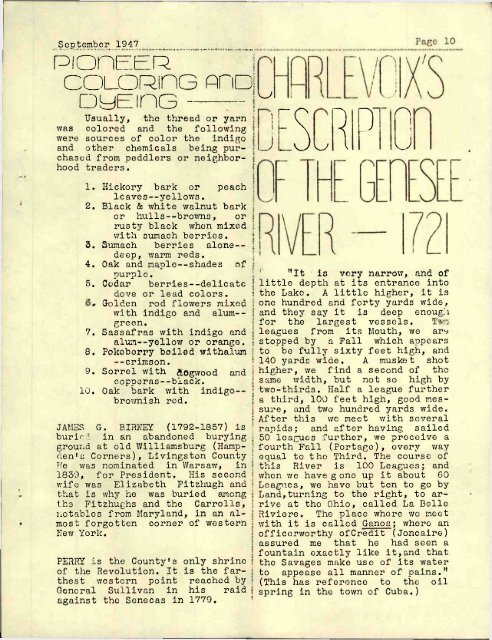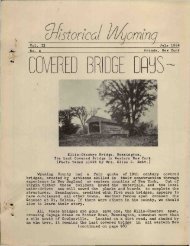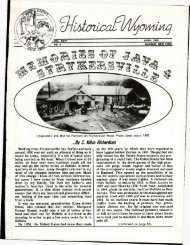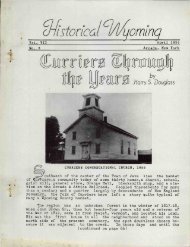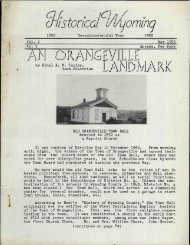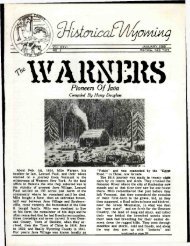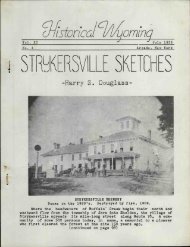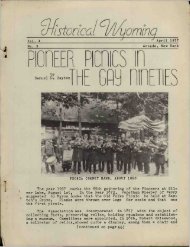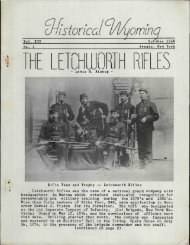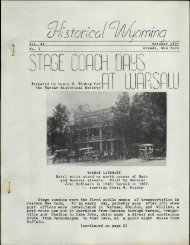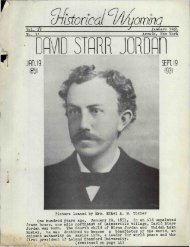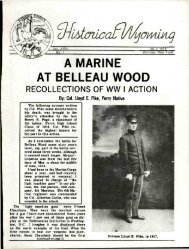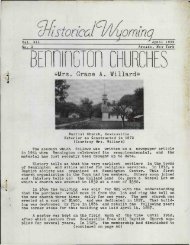Historical Wyoming County September 1947 - Old Fulton History
Historical Wyoming County September 1947 - Old Fulton History
Historical Wyoming County September 1947 - Old Fulton History
Create successful ePaper yourself
Turn your PDF publications into a flip-book with our unique Google optimized e-Paper software.
<strong>September</strong> <strong>1947</strong><br />
•. • t ii 11111' 11 r i f 11111 ii 11 f i i i • ti i M«m • MiMiiiui4im»i'>ititliiiil«ilii4tiiiii>iUiili<<br />
PIOnEER<br />
colorhg atd<br />
DUE IPG'——<br />
Usually, the thread or yarn<br />
was colored and the following<br />
were sources of color the indigo<br />
and other chemicals being purchased<br />
from peddlers or neighborhood<br />
traders.<br />
1. Hickory bark or peach<br />
leaves--yellows.<br />
2. Black & white walnut bark<br />
or hulls—browns, or<br />
rusty black when mixed<br />
with sumach berries.<br />
5. Sumach berries alonedeep,<br />
warm reds.<br />
4. Oak and maple--shades<br />
purple.<br />
of<br />
5. Codar berries--delicate<br />
dove or lead colors.<br />
Golden rod flowers mixed<br />
with indigo and<br />
green.alum--<br />
7. Sassafras with indigo and<br />
alum--yellow or orange.<br />
8. Pokeberry boiled withalum<br />
--crimson.<br />
9. Sorrel with ftegwood and<br />
copperas--black.<br />
10. Oak bark with indigobrownlsh<br />
red.<br />
JAMES G. BIRKEY (1792-1857) is<br />
buric 1 in an abandoned burying<br />
ground at old Williamsburg (Hampden's<br />
Corners), Livingston <strong>County</strong><br />
He was nominated in Warsaw, in<br />
1839, for President. His second<br />
wife was Elizabeth Fitzhugh and<br />
that is why he was buried among<br />
the Fitzhughs and the Carrolls,<br />
notables from Maryland, in an almost<br />
forgotten corner of western<br />
New York.<br />
PERRY is the <strong>County</strong>'s only shrine<br />
of the Revolution. It is the farthest<br />
western point reached by<br />
General Sullivan in his raid<br />
against the Senecas in 1779.<br />
w<br />
I<br />
1<br />
I HQ n 11 o i<br />
<<br />
J to O 1 u<br />
"It is very narrow, and of<br />
little depth at Its entrance into<br />
the Lake. A little higher, It is<br />
one hundred and forty yards wide,<br />
and they say It is deep enough<br />
for the largest vessels.<br />
leagues from its Mouth, we ary<br />
stopped by a Fall which appears<br />
to be fully sixty feet high, and<br />
140 yards wide. A musket shot<br />
higher, we find a second of the<br />
same width, but not so high by<br />
two-thirds. Half a league further<br />
a third, 100 feet high, good measure,<br />
and two hundred yards wide«<br />
After this we meet with several<br />
rapids; and after having sailed<br />
50 leagues further, we preceive a<br />
fourth Fall (Portage), every way<br />
equal to the Third. The course of<br />
this River is 100 Leagues; and<br />
when we have g one up it about 60<br />
Leagues, we have but ten to go by<br />
Land,turning to the right, to arrive<br />
at the Ohio, called La Belle<br />
Riviere. The place where wo meet<br />
with It is called Ganos; where an<br />
officerworthy ofCredit (Joncaire)<br />
assured me that he had seen a<br />
fountain exactly like it,and that<br />
the Savages make use of its water<br />
to appease all manner of pains."<br />
(This has reference to the oil<br />
spring in the town of Cuba.)


